Aspects of Hexavalent Chromium Pollution of Thebes Plain Aquifer, Boeotia, Greece
Abstract
:1. Introduction
2. Generally Information about Chromium
2.1. Oxidation States of Chromium
2.2. Isotopic Chemistry
Stable Isotopes Chromium Systematics
- Rsample: the 53Cr/52Cr ratio in the sample water
- Ro: the initial 53Cr/52Cr ratio
- C: the concentration of Cr in the sample water
- Co: the initial Cr concentration of the sample
- α: Cr fractionation factor
- δ53Cr is related with Rsample with the following equation
2.3. Strontium Isotopes Systematics
3. Geology and Hydrogeology
3.1. Hydrogeological Aspects
3.2. Sampling Campaign
3.3. Anthropogenic Sources of Pollution
4. Material and Methods
4.1. Major Chemistry and Heavy Metals
4.2. Isotopic Ratios
4.2.1. Stable Isotopes of Chromium
4.2.2. Strontium Isotopic Measurements
5. Results and Discussion
5.1. Physicochemical Properties
5.2. Anions and Cations
5.3. Trace Elements and SiO2
5.4. Heavy Metals and Chromium
5.5. Isotopic Compositions
6. Conclusions
Acknowledgments
Conflicts of Interest
References
- Bourotte, C.; Bertolo, R.; Almodovar, M.; Hirata, R. Natural occurrence of hexavalent chromium in a sedimentary aquifer in Urania, State of Sao Paulo, Brazil. Ann. Braz. Acad. Sci. 2009, 81, 227–242. [Google Scholar] [CrossRef]
- Fantoni, D.; Brozzo, G.; Canepa, M.; Cipolli, F.; Marini, L.; Ottonello, G.; Zuccolini, M.V. Natural hexavalent chromium in groundwaters interacting with ophiolitic rocks. Environ. Geol. 2002, 42, 871–882. [Google Scholar] [CrossRef]
- Armenita, M.A.; Quere, A. Hydrogeochemical behavior of chromium in the unsaturated zone and in the aquifer of Leon Valley, Mexico. Water Air Soil Pollut. 1995, 84, 11–29. [Google Scholar] [CrossRef]
- Izbiki, J.A.; Ball, J.W.; Bullen, T.D.; Sutley, S.J. Chromium, chromium isotopes and selected trace elements, western Mojave Desert, U.S.A. Appl. Geochem. 2008, 23, 1325–1352. [Google Scholar] [CrossRef]
- Dash, P.; Silwal, S.; Ikenga, J.O.; Pinckney, J.L.; Arslan, Z.; Lizotte, R.E. Water Quality of Four Major Lakes in Mississippi, USA: Impacts on Human and Aquatic Ecosystem Health. Water 2015, 7, 4999–5030. [Google Scholar] [CrossRef]
- Potasznik, A.K.; Szymczyk, S.; Skwierawski, A.; Lewczuk, K.G.; Cymes, I. Heavy Metal Contamination in the Surface Layer of Bottom Sediments in a Flow-Through Lake: A Case Study of Lake Symsar in Northern Poland. Water 2016, 8, 358. [Google Scholar] [CrossRef]
- Economou-Eliopoulos, M.; Frei, R.; Atsarou, C. Application of chromium stable isotopes to the evaluation of Cr (VI) contamination in groundwater and rock leachates from central Euboea and the Assopos basin (Greece). Catena 2014, 122, 216–228. [Google Scholar] [CrossRef]
- Megremi, I. Distribution and bioavailability of Cr in central Euboea, Greece. Cent. Eur. J. Geosci. 2009. [Google Scholar] [CrossRef]
- Cary, E.E. Chromium in air, soil, and natural waters. Biological and Environmental Aspects of Chromium. In Topics in Environmental Health; Elsevier Biomedical Press: New York, NY, USA, 1982; pp. 49–64. [Google Scholar]
- National Institute for Occupational Safety and Health (NIOSH). Online Pocket Guide to Chemical Hazards. NIOSH, 1999. Available online: http://www.cdc.gov/niosh/npg/npg.html (accessed on 8 August 2017).
- Ljujic, B.; Sundac, Lj. Council Directive 98/83/EC Directive of the European Parliament on the Quality of Water Intended for Human Consumption; The European Parliament and the Council of the European Union, Off J L 330; European Union: Brussels, Belgium, 1998. [Google Scholar]
- Word Health Organization (WHO). International Standards for Drinking Water. Switzerland, Italy, 1971. Available online: http://apps.who.int/iris/bitstream/10665/43845/1/a91160.pdf (accessed on 8 August 2017).
- Michalopoulou, E. Legislation for the Environment; Ziti Publications: Athens, Greece, 2004. [Google Scholar]
- Lewis, R.J. Sax’s Dangerous Properties of Industrial Materials, 8th ed.; Van Nostrand Reinhold: New York, NY, USA, 1992; Volume II. [Google Scholar]
- Thornton, I. Geochemistry applied to agriculture. In Applied Environmental Geochemistry; Academic Press: London, UK, 1983; pp. 231–266. [Google Scholar]
- Mimides, Th. Investigation of Agricultural Products for Toxic Pollutants in Thebe’s Municipality; Thebe’s: Thebs, Greece, 2011. [Google Scholar]
- Testa, S. Sources of Chromium Contamination in Soil and Groundwater. In Cr(VI) Handbook; CRC Publications: New York, NY, USA, 2005. [Google Scholar]
- Morning, J.L.; Matthews, N.A.; Peterson, E.C. Chromium in Mineral Facts and Problems. In Bulletin 671; U.S. Bureau of Mines: Washington, DC, USA, 1989; pp. 167–182. [Google Scholar]
- Hem, J. Study and Interpretation of the Chemical Characteristics of Natural Water, 3rd ed.; U.S.G.S.: Alexandria, VA, USA, 1979.
- Steinpress, M. Naturally Occurring Chromium(VI) in Groundwater. In Cr(VI) Handbook; CRC Publications: New York, NY, USA, 2005. [Google Scholar]
- Schoenberg, R.; Zink, S.; Staubwasser, M.; von Blanckenburg, F. The stable Cr isotope inventory of solid Earth reservoirs determined by double spike MC-ICP-MS. Chem. Geol. 2008, 249, 294–306. [Google Scholar] [CrossRef]
- Motzer, W. Chemistry, Geochemistry and Geology of Chromium. In Cr(VI) Handbook; CRC PRESS: New York, NY, USA, 2005. [Google Scholar]
- Vasilatos, C.; Megremi, I.; Economou-Eliopoulos, M.; Mitsis, I. Hexavalent chromium and other toxic elements in natural waters in the Thiva–Tanagra–Malakasa Basin, Greece. Hell. J. Geosci. 2008, 43, 57–66. [Google Scholar]
- Mimides, T. Management and Protection of the Avlonas Area; Research work; Agricultural University of Athens: Athens, Greece, 2007. [Google Scholar]
- Economou-Eliopoulos, M.; Antivachi, D.; Vasilatos, C.; Megremi, I. Evaluation of the Cr (VI) and other toxic element contamination and their potential sources: The case of the Thiva basin (Greece). Geosci. Front. 2011. [Google Scholar] [CrossRef]
- Dermatas, D.; Vatseris, C.; Panagiotakis, I.; Chrysochoou, M. Potential Contribution of geogenic chromium in groundwater contamination of a Greek heavily industrialized area. Chem. Eng. Trans. 2012, 28. [Google Scholar] [CrossRef]
- Tziritis, E.; Kelepertzis, E.; Korres, G.; Perivolaris, D.; Repani, S. Hexavalent Chromium Contamination in Groundwaters of Thiva Basin, Central Greece. Environ. Contam. Toxicol. 2012, 89, 1073–1077. [Google Scholar] [CrossRef] [PubMed]
- Institute of Geological and Mineral Exploration of Greece (IGME). Pollution Factors in Boeotia Prefecture (E.U. Project); IGME: Athens, Greece, 2010. [Google Scholar]
- Raddatz, A.L.; Johnson, T.M.; MicLing, T.L. Cr stable isotopes in Snake River Plain Aquifer groundwater: Evidence for natural reduction of dissolved Cr (VI). Environ. Sci. Technol. 2011, 45, 502–507. [Google Scholar] [CrossRef] [PubMed]
- Mimides, T. Hydrogeochemical Autopsy of Stable Chromium Isotopes in Order to Investigate Its Human and Natural Origin; Euboea–Psachna (Technical Report); Agricultural University of Athens: Athens, Greece, 2015. [Google Scholar]
- Mathess, J. The Properties of Groundwater; Willey Publications: New York, NY, USA, 1995. [Google Scholar]
- Mimides, T.; Koilakos, D. Soil chemistry of Boeotia prefecture and application of Yttrium normalization theory for explaining the origin of chromium in soil. In Proceedings of the CRETE 2014 Conference, Chania, Greece, 7–10 September 2014. [Google Scholar]
- Richard, F.C.; Bourg, A.C. Aqueous geochemistry of chromium: A review. Water Resour. 1991, 25, 807–816. [Google Scholar] [CrossRef]
- Stanin, F. The Transport and Fate of Chromium (VI) in the Environment. In Hexavalent Chromium Handbook; CRC Publications: New York, NY, USA, 2005. [Google Scholar]
- Schroeder, D.; Lee, F. Potential Transformations of Chromium in Natural Waters; Institute for Environmental Sciences; University of Texas-Dallas: Richardson, TX, USA, 1974. [Google Scholar]
- Bartlett, R.J. Chromium cycling in soils and water: Links, gaps, and methods. Environ. Health Perspect. 1991, 92, 17–24. [Google Scholar] [CrossRef] [PubMed]
- Fendorf, S.E.; Zasoski, R.J. Chromium(III) oxidation by MnO2, part 1. characterization. Environ. Sci. Technol. 1992, 26, 79–85. [Google Scholar] [CrossRef]
- Balance Chemical Equation—Online Balancer. Available online: http://www.webqc.org/balance.php (accessed on 9 August 2017).
- Davis, A.; Olsen, R.L. The geochemistry of chromium migration and remediation in the subsurface. Ground Water 1995, 33, 759–768. [Google Scholar] [CrossRef]
- Rai, D.; Sass, B.M.; Moore, D.A. Chromium(III) hydrolysis constants and solubility of chromium(III) hydroxide. Inorg. Chem. 1987, 26, 345–349. [Google Scholar] [CrossRef]
- Stollenwerk, K.G.; Grove, D.B. Adsorption and desorption of hexavalent chromium in an alluvial aquifer near Telluride, Colorado. J. Environ. Qual. 1985, 14, 150–155. [Google Scholar] [CrossRef]
- Viamajala, S.; Peyton, B.M.; Apel, W.A.; Petersen, J.N. Chromate reduction in shewanella oneidensis MR-1 is an inducible process associated with anaerobic growth. Biotechnol. Prog. 2002, 18, 290–295. [Google Scholar] [CrossRef] [PubMed]
- Ellis, A.S.; Johnson, T.M.; Bullen, T.D. Chromium isotopes and the fate of hexavalent chromium in the environment. Environ. Sci. 2002, 295, 2060–2062. [Google Scholar] [CrossRef] [PubMed]
- Johnson, T.M. Stable Isotopes of Cr and Se as Tracers of Redox Processes in Earth Surface Environments; Springer: Berlin, Germany, 2011; p. 239. [Google Scholar]
- Barbieri, M.; Boschetti, T.; Petitta, M.; Tallini, M. Stable isotope (2H, 18O and 87Sr/87Sr) and hydrochemistry monitoring for groundwater hydrodynamics analysis in a karst aquifer (Gran Sasso, Central Italy). Appl. Geochem. 2005. [Google Scholar] [CrossRef]
- Barbieri, M.; Morotti, M. Hydrogeochemistry and strontium isotopes of spring and mineral waters from Monte Vulture volcano, Italy. Appl. Geochem. 2003, 18, 117–125. [Google Scholar] [CrossRef]
- Barbieri, M.; Nigro, A.; Petitta, M. Groundwater mixing in the discharge area of San Vittorino Plain (Central Italy): Geochemical characterization and implication for drinking uses. Environ. Earth Sci. 2017. [Google Scholar] [CrossRef]
- Negrel, P.; Roy, S. Rain chemistry in the Massif Central (France). A strontium isotopic and major elements study. Appl. Geochem. 1998, 13, 941–952. [Google Scholar] [CrossRef]
- Brass, G. The variation of the marine 87Sr/86Sr ratio during Phanerozoic time: Interpretation using a flux model. Geoch. Cosmoch. Acta 1978, 40, 721–730. [Google Scholar] [CrossRef]
- Dotsika, E.; Poutoukis, D.; Kloppmann, W.; Guerrot, C.; Voutsa, D.; Kouimtzis, T.H. The use of O, H, B, Sr and S isotopes for tracing the origin of dissolved boron in groundwater in Central Macedonia, Greece. Appl. Geochem. 2010. [Google Scholar] [CrossRef]
- Negrel, P.; Dupre, B.; Seimbille, F.; Allegre, C.J. Quantitative modelisation of differential erosion between crystalline and sedimentary area of a French basin by isotopic analysis of strontium in river waters. Chem. Geol. 1988, 70, 13. [Google Scholar] [CrossRef]
- Negrel, P.; Deschamps, P. Natural and anthropogenic budgets of a small watershed in the Massif Central (France): Chemical and strontium isotopic and major elements study. Aquat. Geochem. 1997, 2, 1–27. [Google Scholar] [CrossRef]
- Institute of Geological and Mineral Exploration of Greece (IGME). Thebes Sheet; IGME: Athens, Greece, 1967. [Google Scholar]
- Koumantakis, I. Hydrogeological Conditions of Thebes Basin Athens-Greece; NTUA: Athens, Greece, 1980. [Google Scholar]
- Parks, J.L.; Mc Neill, L.; Frey, M.; Eaton, A.D.; Haghani, A.; Ramirez, L.; Edwards, M. Determination of total chromium in environmental water samples. Water Res. 2004, 38, 2827–2838. [Google Scholar] [CrossRef] [PubMed]
- METROHM. Introduction to Polarography and Voltammetry; Metrohm: Stockholm, Sweden, 2010. [Google Scholar]
- METROHM. Ion Analysis, Chromium in Waste Water; Metrohm: Stockholm, Sweden, 2010. [Google Scholar]
- Hach. DR 2800 Spectrophotometer; Hach: Dusseldorf, Germany, 2007. [Google Scholar]
- Trinquier, A.; Elliott, T.; Ulfbeck, D.; Coath, C.; Krot, A.N.; Bizzarro, M. Origin of nucleosynthetic isotope heterogeneity in the solar protoplanetary disk. Science 2009, 324, 374–376. [Google Scholar] [CrossRef] [PubMed]
- Horwitz, E.P.; Dietz, M.L.; Fisher, D.E. Separation and preconcentration of strontium from biological, environmental, and nuclear waste samples by extraction chromatography using a crown ether. Anal. Chem. 1991. [Google Scholar] [CrossRef]
- Soulios, G. General Hydrogeology—Volume 4; University Studio Press: Thesaloniki, Greece, 2006. [Google Scholar]

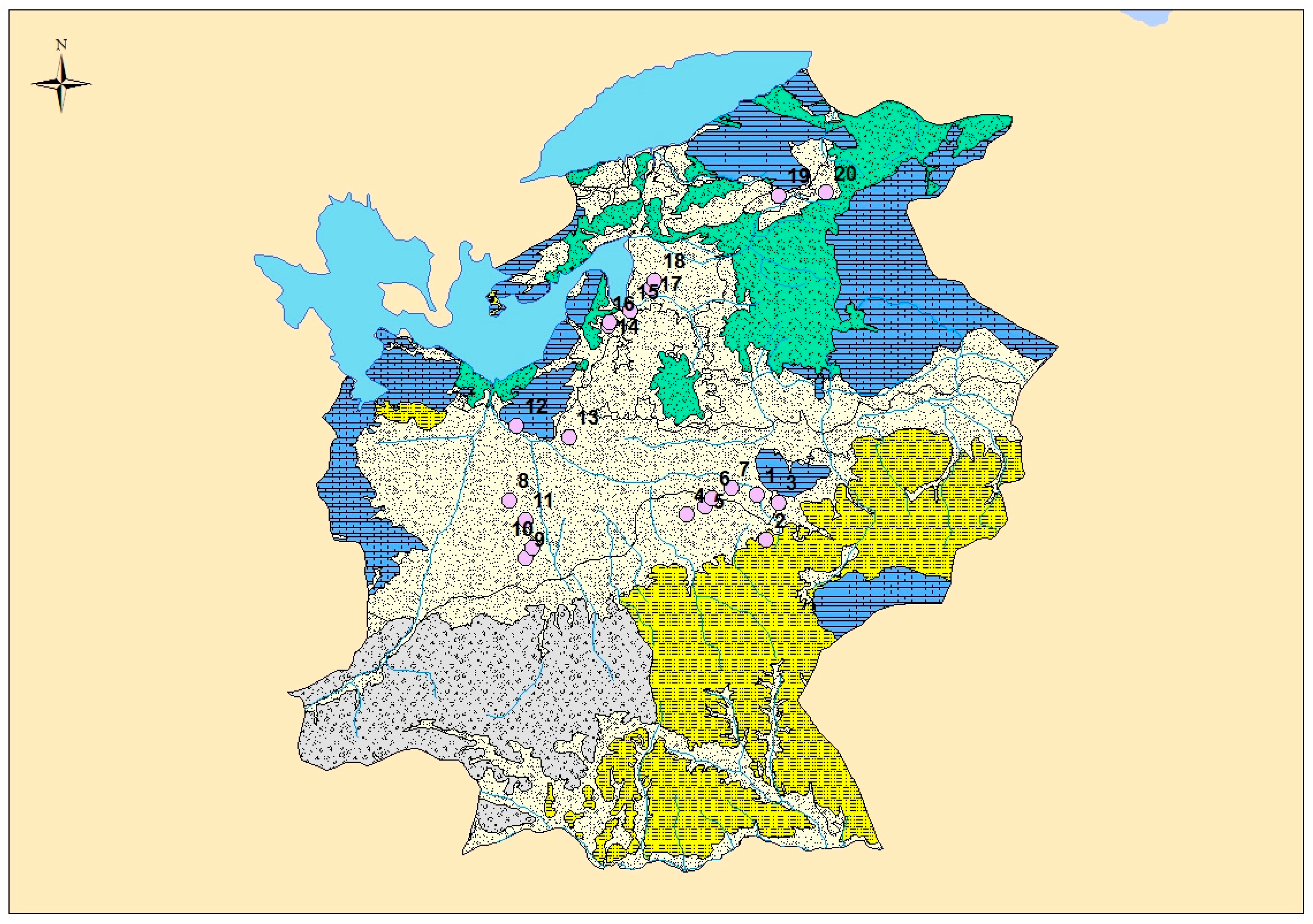
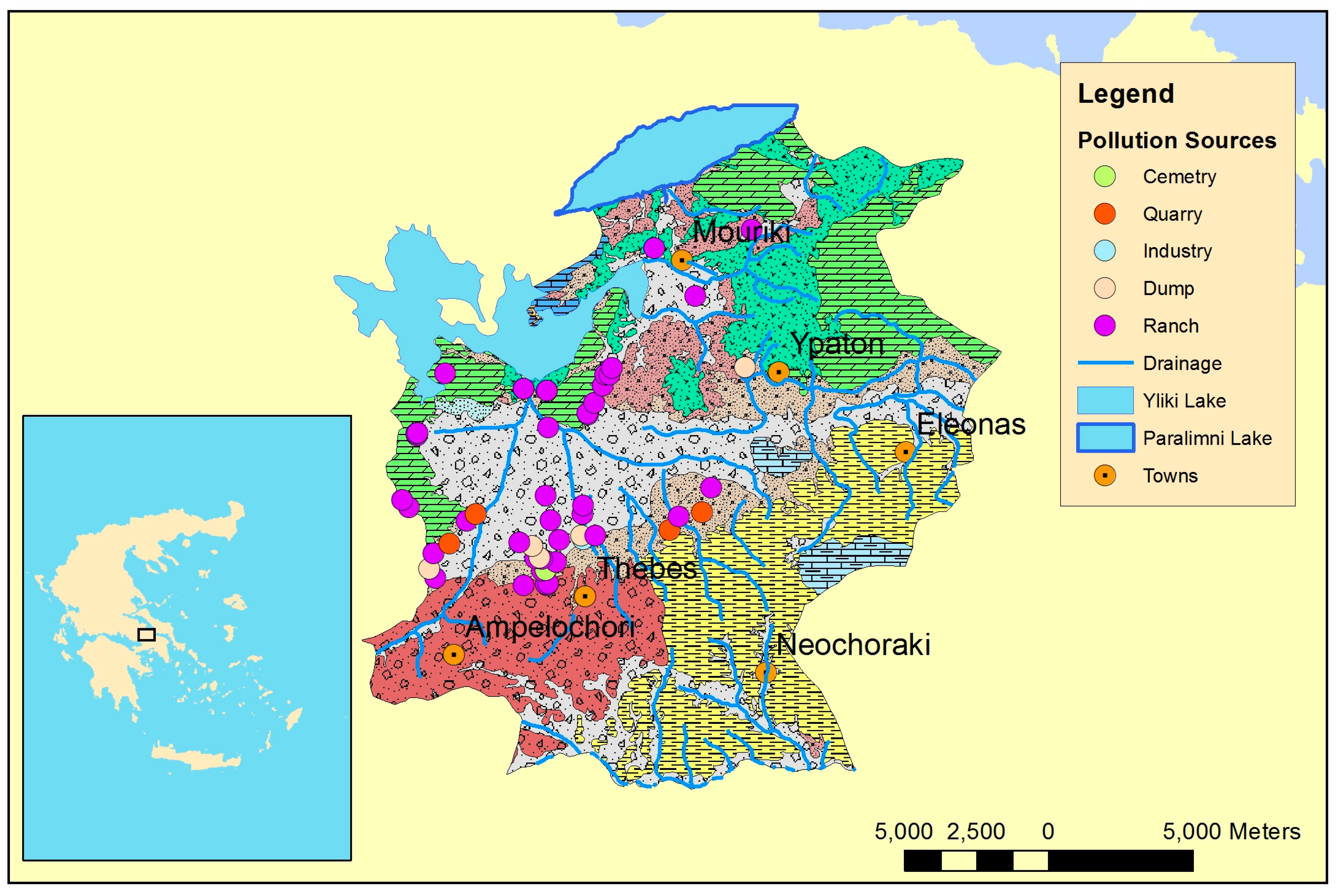
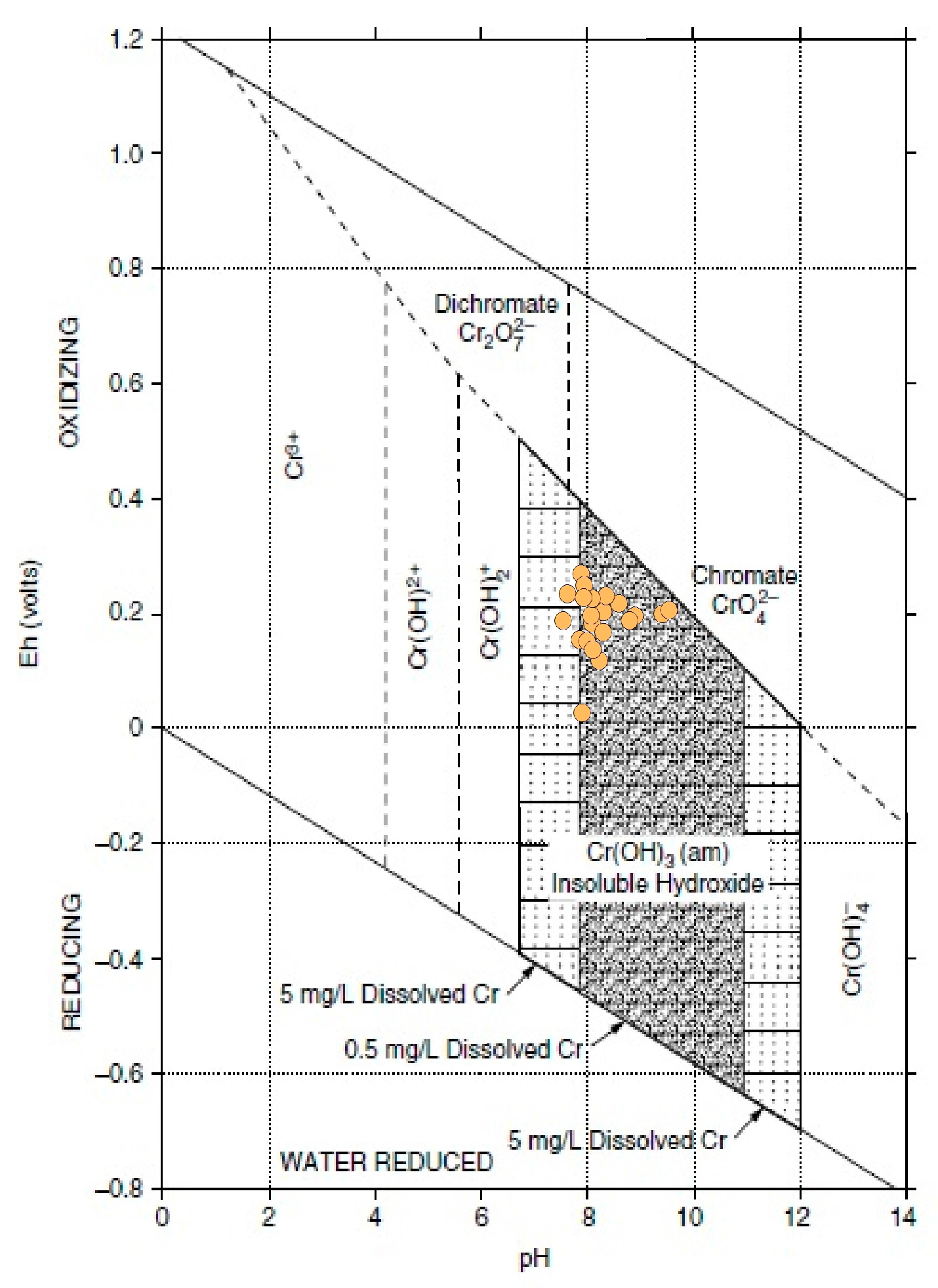
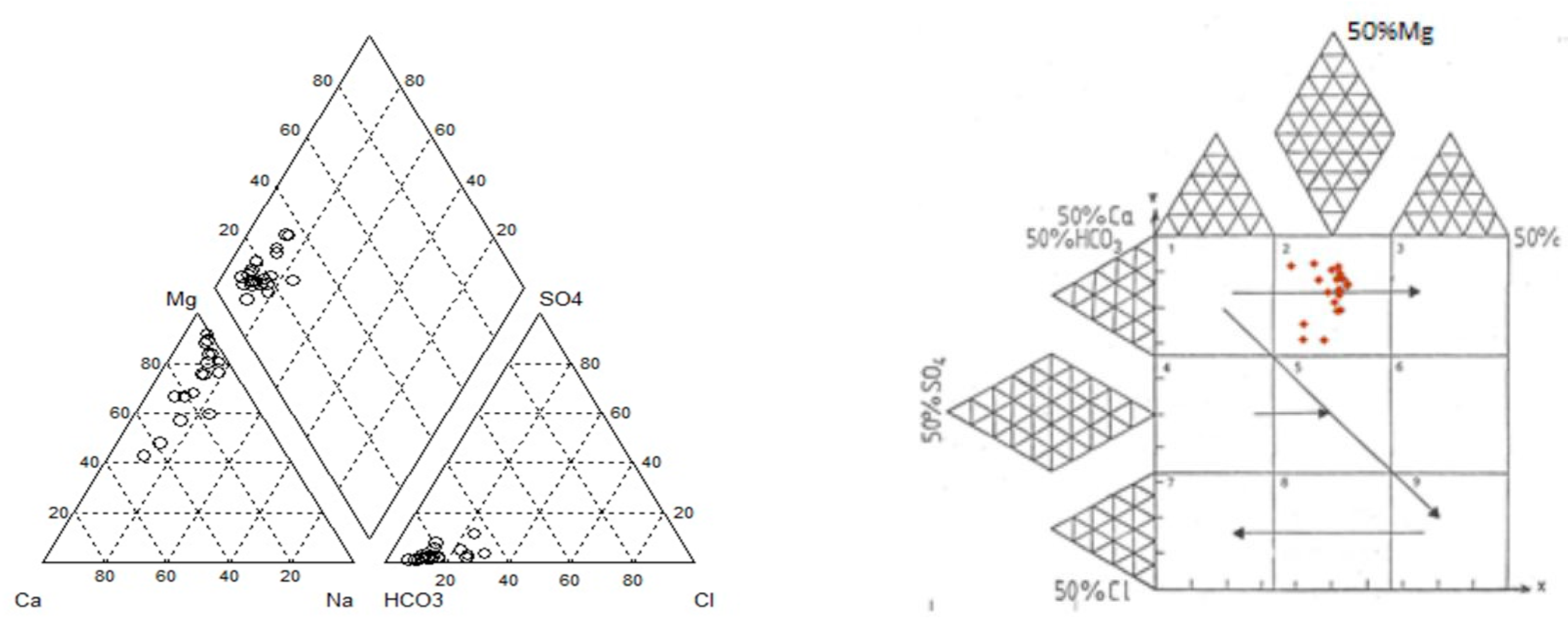
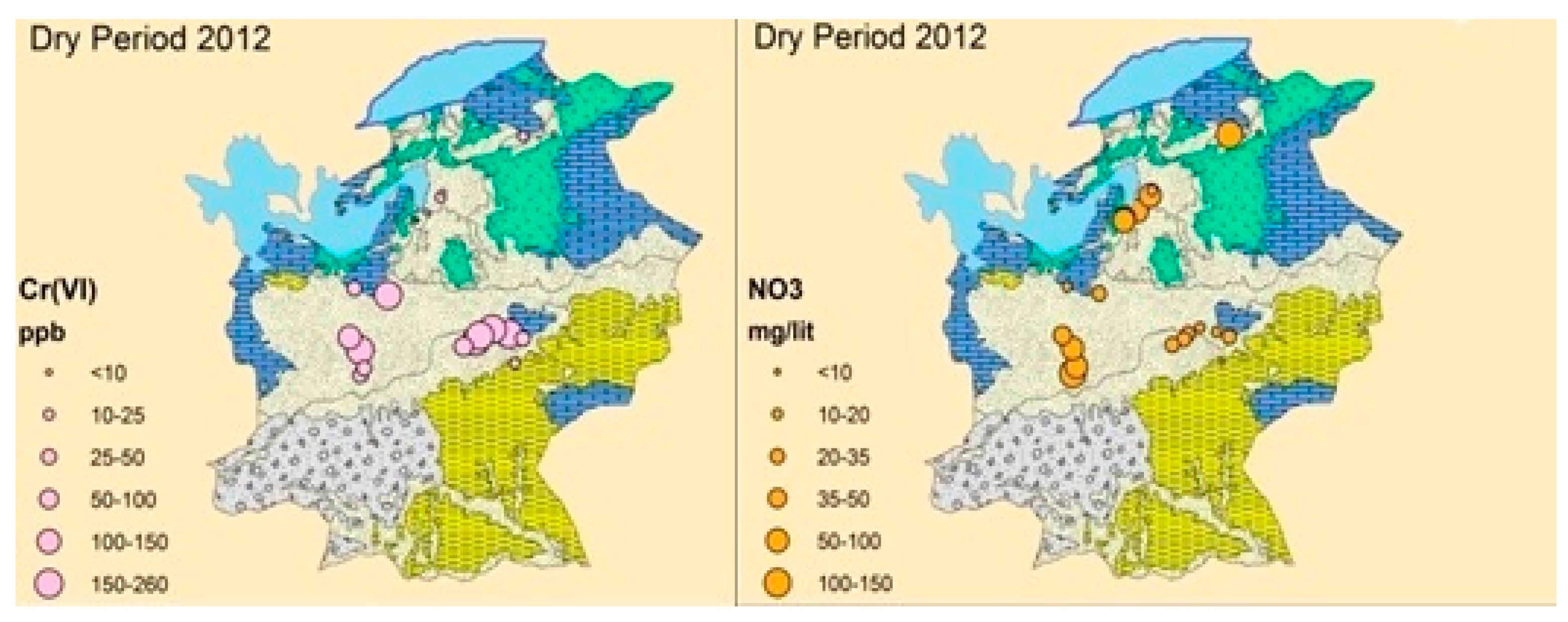

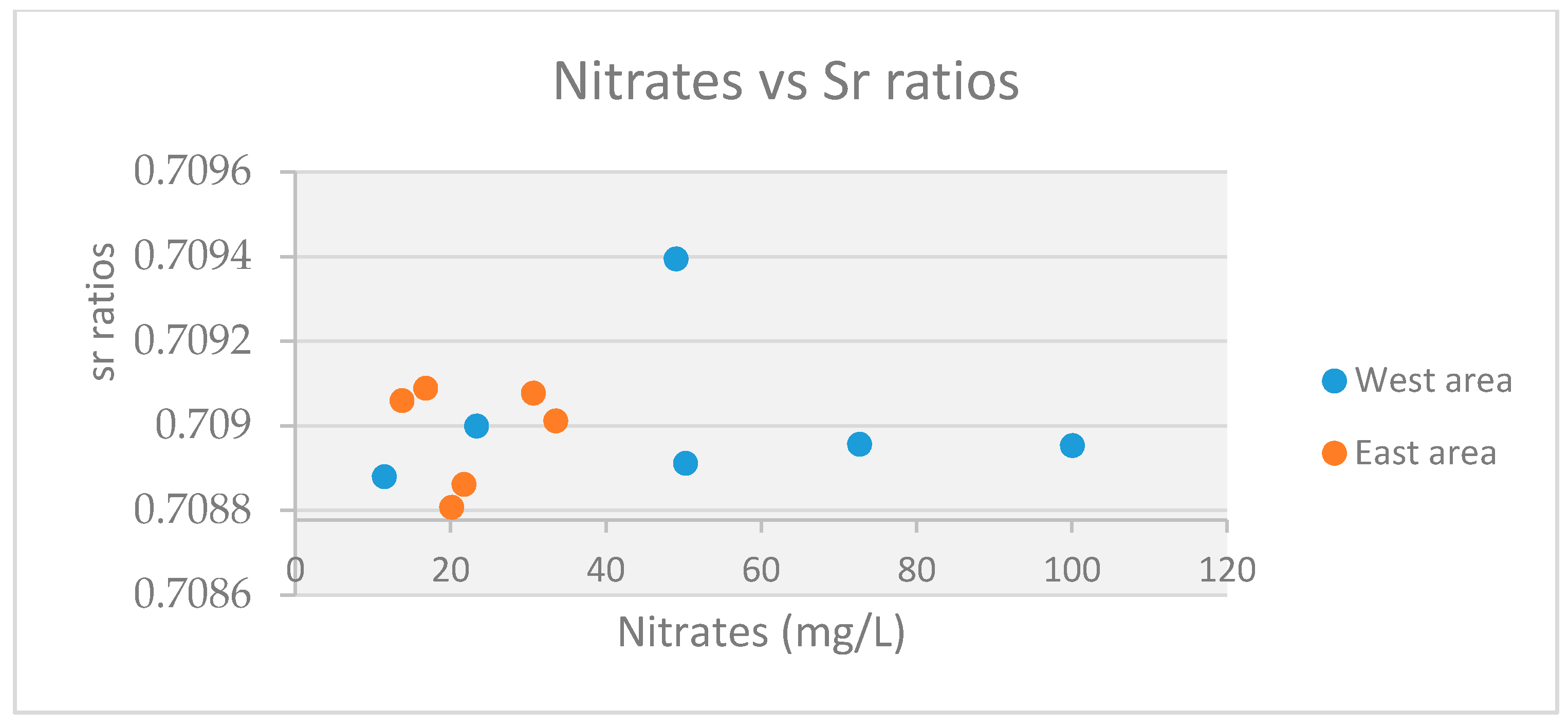
| Parameter | Unit | Average | St. Dev. | Min. | Max. | N |
|---|---|---|---|---|---|---|
| Cond | μs/cm | 736.6 | 119.7 | 466 | 957 | 20 |
| D.O. | mg/L | 8.89 | 4.2 | 2.4 | 14.4 | 20 |
| pH | 8.18 | 1.2 | 7.4 | 9.41 | 20 | |
| Eh | mV | 157.65 | 60.3 | 80 | 268 | 20 |
| T | °C | 21 | 0.4 | 20 | 21.9 | 20 |
| F− | mg/L | 0.2 | 0.1 | 0.1 | 0.5 | 19 |
| Cl− | mg/L | 42 | 18.7 | 16 | 80.9 | 20 |
| Br− | mg/L | 1.2 | 0.2 | 0.9 | 1.7 | 20 |
| NO3− | mg/L | 44.9 | 36.9 | 4.6 | 145 | 20 |
| SO4− | mg/L | 12.5 | 9.8 | 3.3 | 45.7 | 20 |
| HCO3− | mg/L | 375.5 | 66.5 | 280 | 540 | 20 |
| Na+ | mg/L | 26 | 9.2 | 10 | 50.3 | 20 |
| K+ | mg/L | 1.7 | 2.5 | 0.2 | 9.9 | 20 |
| Ca2+ | mg/L | 25 | 26.4 | 2.9 | 92.6 | 20 |
| Mg2+ | mg/L | 81.1 | 20.1 | 42 | 122 | 20 |
| SiO2 | mg/L | 36.1 | 21.6 | 13 | 87 | 20 |
| Cr (VI) | μg/L | 80.8 | 79.2 | 3 | 255 | 20 |
| Zn | μg/L | 137.4 | 341.2 | 19 | 1500 | 18 |
| Pb | μg/L | 13 | 4.6 | 3 | 19.4 | 18 |
| Cu | μg/L | 8.8 | 17 | 2.2 | 75.6 | 18 |
| Sample | Crtot (μg/L) | Cr(VI) (μg/L) | Cr(VI)/Crtot % | NO3− (mg/L) | δ53Cr | 87Sr/86Sr |
|---|---|---|---|---|---|---|
| 1 | 257 | 255 | 0.78% | 13.773 | 0.99 | 0.709059 |
| 3 | 67 | 48 | 28.36% | 33.558 | 1.99 | 0.709011 |
| 4 | 112 | 100 | 10.71% | 20.142 | 0.94 | 0.708807 |
| 5 | 190 | 185 | 2.63% | 21.736 | 1.00 | 0.708861 |
| 6 | 178 | 159 | 10.67% | 30.664 | 0.94 | 0.709077 |
| 7 | 186 | 172 | 7.53% | 16.823 | 1.08 | 0.709088 |
| 8 | 159 | 145 | 8.81% | 49.046 | 1.10 | 0.709394 |
| 9 | 112 | 48 | 57.14% | 100.084 | 0.91 | 0.708952 |
| 10 | 78 | 44 | 43.59% | 72.678 | 0.93 | 0.708956 |
| 11 | 156 | 153 | 1.92% | 50.261 | 0.90 | 0.708911 |
| 12 | 44 | 31 | 29.55% | 11.473 | 0.62 | 0.708878 |
| 13 | 185 | 179 | 3.24% | 23.348 | 0.76 | 0.708998 |
| Average | 144 | 127 | 17.08% | 36.96 | 1.01 | 0.708999 |
© 2017 by the author. Licensee MDPI, Basel, Switzerland. This article is an open access article distributed under the terms and conditions of the Creative Commons Attribution (CC BY) license (http://creativecommons.org/licenses/by/4.0/).
Share and Cite
Koilakos, D.I. Aspects of Hexavalent Chromium Pollution of Thebes Plain Aquifer, Boeotia, Greece. Water 2017, 9, 611. https://doi.org/10.3390/w9080611
Koilakos DI. Aspects of Hexavalent Chromium Pollution of Thebes Plain Aquifer, Boeotia, Greece. Water. 2017; 9(8):611. https://doi.org/10.3390/w9080611
Chicago/Turabian StyleKoilakos, Dimitrios I. 2017. "Aspects of Hexavalent Chromium Pollution of Thebes Plain Aquifer, Boeotia, Greece" Water 9, no. 8: 611. https://doi.org/10.3390/w9080611




